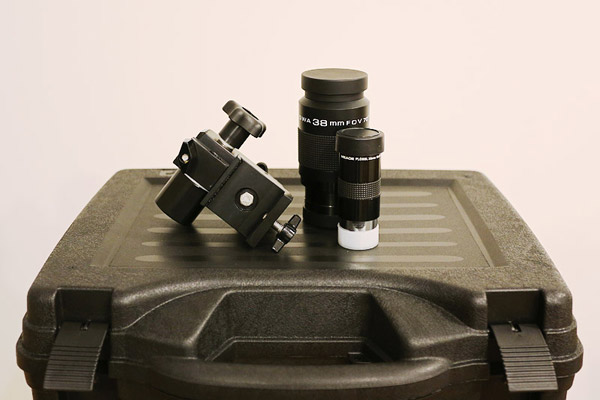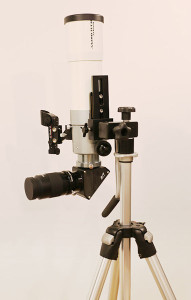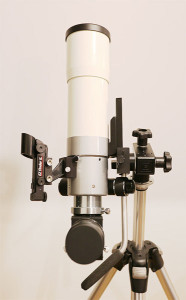
The DwarfStar along side 2″ 38mm SWA and 1.25″ 32mm Plossl eyepieces. This photo shows the saddle rotated so the handle mounting block is within the profile of the head for minimum packed size.
A compact but sturdy mount is the foundation of any quick grab or travel observing setup. A mount that is light weight but overly shaky at the eyepiece can sap the joy out of observing, while a solid but heavy mount can be a chore to transport and deploy. When looking for a portable mount to use with small telescopes the path between these two extremes can be a fine line to tread.
Universal Astronomics is a small, New England based manufacturer of astronomical mounts. While researching the options for well built, manual alt-az mounts their products seemed widely recommended so I decided to take a closer look at their line-up. After spending some time on the UA web site and contacting the owner, Larry Patriarca, for his recommendations I chose the DwarfStar for my purposes.
The UA DwarfStar is an incredibly compact mount, weighing about a pound and rated (conservatively) for loads up to 8 lbs. The saddle accepts a standard Vixen-style dovetail, which is secured by a thumbscrew clamp. The mount features large tension adjustment knobs for fine tuning of both motions. An eyepiece tray and guide handle are optional additions.
Being about an hour’s drive from UA’s Webster, Massachusetts location, I was able to meet Larry at his shop and try the mount in person. Larry is fantastic to work with; he has a passion for astronomy and genuinely wants everyone to enjoy using their telescope as much as he does.
Larry demonstrated the DwarfStar and showed me how the guide handle was attached. At one point I questioned the amount of leverage provided by the standard 7″ guide handle; not due to any shortcoming in the smoothness of the mount but because I like the fine control a longer lever gives. Larry explained that the larger mounts user longer handles but he kept the DwarfStar’s handle shorter for portability. We talked about how quickly the handle detaches and how the mounting design allows the length to be adjusted on the fly. Larry also saw that my Bogen tripod’s elevator column would allow a longer handle to work well so he took me back to the machine shop and quickly fabricated a longer 12″ handle while I watched.
The DwarfStar is assembled with the saddle on the right side but it is a simple matter to swap the saddle to the other side of the mount body allowing it to work with scopes designed to be mounted from either position.
In use the DwarfStar is exceedingly simple. The key to being able to tension the mount for smoothest movement is to ensure the front to back balance of the scope in the dovetail saddle; the scope should balance with minimal tension on the altitude axis. Once the balance point is found the clamp screw can be tightened and the tension set as desired for observing.
The additional leverage provided by the guide handle makes it easy to point the telescope where you want to look. As the viewing magnification increases the required input movement becomes smaller and by 200x motions are touchy though tracking at this power is achievable without too much trouble. Overall the DwarfStar lets me focus on observing and not worry about the mount.
The DwarfStar works well with a range of telescope sizes (everything from a short tube 60mm refractor to a 5″ SCT) allowing you to optimize your mount to prioritize portability or sturdiness by your choice of a tripod. Most often I use a Bogen 3011 (current equivalent is the Manfrotto 055) as its 5 lb weight and level of stability is a good match for an 80mm f/6 triplet refractor or the AWB OneSky.
With two of the 3011’s three leg sections extended the scope is positioned at a good height for seated viewing and vibrations damp in under 2 seconds at 100x on asphalt. Extending all three leg sections for standing viewing increases the dampening time to 4 seconds. Dampening times can also be reduced by viewing on grass or using vibration suppression pads.
When using a smaller, lighter scope or being less demanding at higher magnifications a lighter tripod such as my Bogen 3001 (Manfrotto 190) can be used. My Orion ST-80 works well with this setup as I rarely bring its power over 100x.
The cost of the DwarfStar combined with a good tripod may seem steep compared to some full-sized astro mounts but the value of such a light weight, easy to deploy observing setup becomes apparent as you find yourself going out to observe more often or more easily bringing a telescope along on trips. My Bogen 3011 and DwarfStar see frequent use with various telescopes both at home, as a quick grab astro or bird watching setup, and on the road.
-Dave
Original content copyright 2015 by David Philips. All Rights Reserved. This post may contain links to affiliate sites; sales through affiliate links may benefit this site.

